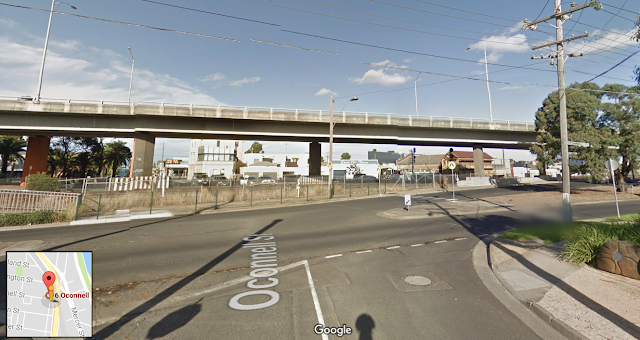Misfortune...
 |
| First work locomotive reaching Hurstbridge during the extension of the railway line from Eltham to Hurstbridge. Source: Picture Victoria. Copyright Nillumbik Historical Society |
Last week, I told the story of John and Goymer Shorten and their illegal exploits in several counties in England, discussing their luck in narrowly avoiding a Capitol sentence after they were apprehended for horse stealing. Week 12 of #52ancestors gives us the prompt of "misfortune." Misfortune is defined as bad luck; an unfortunate condition or event. For John Maguire, that unfortunate event occurred on Thursday, 2nd October 1913.
John Michael Maguire (sometimes Maguire, sometimes McGuire) was the first born of Patrick Maguire and Elizabeth Monaghan, and was my 2nd great-granduncle. He was born around 1857 in County Meath, Ireland and traveled with his parents and his younger brother Patrick Michael (my x2 great grandfather) from Liverpool, England to Melbourne, Australia aboard the Phoenix on 21 July 1862. They were unassisted passengers, meaning they paid for their own passage to Australia, or were privately sponsored.
Patrick, Elizabeth and their two boys settled in Ashby, Victoria where their family continued to grow. Ashby was once a suburb of Geelong (renamed to Geelong West in 1875). By 1850 this area had become known as Little Scotland, and Kildare and referred to the area between Autumn Street and Waratah Street. It is here that Patrick and Elizabeth raised their family to 12 children, only 9 of which would survive early childhood.
John spent his life in Geelong, where he worked as a labourer. He never married and never had any children and appeared to live with his brothers and father for most of his life.
In 1903, John and his brother Thomas along with their father Patrick were living in Beattie's Lane, Geelong.
Two years later, John, his brothers James and Thomas, and his father Patrick McGuire were all living at 63 Preston Street, Geelong where all but Thomas were employed as labourers. Thomas was employed as a shoemaker.
By 1908, John, James, Thomas and their father Patrick McGuire were living at 6 O'Connell Street, Geelong. At the time of his death in 1913, John was still living at O'Connell street whilst his brothers moved on to Yuille Street. He was employed as a wharf labourer.
On Thursday 2nd October 1913, John and a companion named Robert J. Cason were proceeding through the O'Connell Street swing gates over the railway line in Geelong shortly after 9pm, on their way to Mercer Street. They halted at the railway line to allow the last train out from Melbourne to pass. When the train had gone by the two men stepped forward, and were horrified to find the pilot engine almost on top of them. A pilot engine is a locomotive sent ahead of a train to check the track for safety and clearance. Whilst both men were between the rails, Mr Cason managed to jump clear but John was caught between the buffers (which are fitted at the end of vehicle frames, one at each corner. They are projecting, shock-absorbing pads used as a part of the buffers-and-chain coupling system).
The driver of the engine, H.P. Lee stated that he saw the men, arm in arm, crossing the line, and blew the whistle. He also shouted loudly to them. His statement was corroborated by his fireman, Thomas Callahan.
The man in charge of the locomotive pulled up promptly, and before the engine had cleared John. He was brought out from underneath by some of the railway employees. His left foot was amputated, and his right lower leg was badly crushed and hanging by a few shreds of tissue [source: The Colac Herald, 6 October 1913, p.3].
First aid was rendered by some of the railway men in the form of a tourniquet to each limb to attempt to stop the hemorrhage, and in the meantime others telephoned Dr. Morgan and the ambulance. Word was also sent to the hospital and to a priest, as it was feared that he might not survive his injuries. On a hand stretcher, John was carried down the railway yard to the station from where he was removed via ambulance to the Geelong Hospital, suffering from loss of blood and shock though he retained consciousness [source: The Argus, 3 October 1913, p.10].
After making an examination, the doctor's came to the conclusion that the only chance of saving John's life rested upon operating as quickly as possible. It was necessary to amputate both legs a little above where they had been crushed by the engine wheels, and that operation was carried out by Dr. McCullum. Almost immediately however, John succumbed from shock and passed away. Apparently throughout the ordeal, "... he had borne his suffering with much fortitude, notwithstanding that he was reminded by some civilians while he was lying on the railway crossing that both his legs were cut off" [source: The Colac Herald, 6 October 1913, p.3].
The deputy coronor, Mr. W. R. Anderson conducted an inquiry on 9 October 1913 regarding John's unfortunate death. Mr. Cadwallader represented the Railway department; Mr. T. E. Corr appeared for the engine driver and the fireman. A verdict was recorded that John came by his death through shock and loss of blood following having been run over by a locomotive, and that no blame was attachable to the crew of the engine. The coroner added a rider that the O'Connell street crossing should be abolished [source: The Age, 9 October 1913, p.10].
John's funeral was held on Saturday 4 October 1913, moving from his brother Thomas' house on Upper Hope Street, Geelong West to the Geelong Eastern Cemetery where he was buried in the Roman Catholic section [source: Geelong Advertiser, 4 October 1913, p.1].
John was apparently well known as a step dancer in his young days [source: The Age, 3 October 1913, p.10]. Step dancing is the generic term for dance styles in which footwork is the most important part of the dance. Let it not be said that fate is without a sense of irony.
~Louise
 |
| County Meath, Ireland. Source: Google Maps |
Patrick, Elizabeth and their two boys settled in Ashby, Victoria where their family continued to grow. Ashby was once a suburb of Geelong (renamed to Geelong West in 1875). By 1850 this area had become known as Little Scotland, and Kildare and referred to the area between Autumn Street and Waratah Street. It is here that Patrick and Elizabeth raised their family to 12 children, only 9 of which would survive early childhood.
John spent his life in Geelong, where he worked as a labourer. He never married and never had any children and appeared to live with his brothers and father for most of his life.
In 1903, John and his brother Thomas along with their father Patrick were living in Beattie's Lane, Geelong.
Two years later, John, his brothers James and Thomas, and his father Patrick McGuire were all living at 63 Preston Street, Geelong where all but Thomas were employed as labourers. Thomas was employed as a shoemaker.
By 1908, John, James, Thomas and their father Patrick McGuire were living at 6 O'Connell Street, Geelong. At the time of his death in 1913, John was still living at O'Connell street whilst his brothers moved on to Yuille Street. He was employed as a wharf labourer.
 |
| Map showing John's house in 1913, 6 O'Connell Street, Geelong. Source: Google Maps |
On Thursday 2nd October 1913, John and a companion named Robert J. Cason were proceeding through the O'Connell Street swing gates over the railway line in Geelong shortly after 9pm, on their way to Mercer Street. They halted at the railway line to allow the last train out from Melbourne to pass. When the train had gone by the two men stepped forward, and were horrified to find the pilot engine almost on top of them. A pilot engine is a locomotive sent ahead of a train to check the track for safety and clearance. Whilst both men were between the rails, Mr Cason managed to jump clear but John was caught between the buffers (which are fitted at the end of vehicle frames, one at each corner. They are projecting, shock-absorbing pads used as a part of the buffers-and-chain coupling system).
The driver of the engine, H.P. Lee stated that he saw the men, arm in arm, crossing the line, and blew the whistle. He also shouted loudly to them. His statement was corroborated by his fireman, Thomas Callahan.
The man in charge of the locomotive pulled up promptly, and before the engine had cleared John. He was brought out from underneath by some of the railway employees. His left foot was amputated, and his right lower leg was badly crushed and hanging by a few shreds of tissue [source: The Colac Herald, 6 October 1913, p.3].
First aid was rendered by some of the railway men in the form of a tourniquet to each limb to attempt to stop the hemorrhage, and in the meantime others telephoned Dr. Morgan and the ambulance. Word was also sent to the hospital and to a priest, as it was feared that he might not survive his injuries. On a hand stretcher, John was carried down the railway yard to the station from where he was removed via ambulance to the Geelong Hospital, suffering from loss of blood and shock though he retained consciousness [source: The Argus, 3 October 1913, p.10].
After making an examination, the doctor's came to the conclusion that the only chance of saving John's life rested upon operating as quickly as possible. It was necessary to amputate both legs a little above where they had been crushed by the engine wheels, and that operation was carried out by Dr. McCullum. Almost immediately however, John succumbed from shock and passed away. Apparently throughout the ordeal, "... he had borne his suffering with much fortitude, notwithstanding that he was reminded by some civilians while he was lying on the railway crossing that both his legs were cut off" [source: The Colac Herald, 6 October 1913, p.3].
The deputy coronor, Mr. W. R. Anderson conducted an inquiry on 9 October 1913 regarding John's unfortunate death. Mr. Cadwallader represented the Railway department; Mr. T. E. Corr appeared for the engine driver and the fireman. A verdict was recorded that John came by his death through shock and loss of blood following having been run over by a locomotive, and that no blame was attachable to the crew of the engine. The coroner added a rider that the O'Connell street crossing should be abolished [source: The Age, 9 October 1913, p.10].
 |
| Modern picture showing train lines where the approximate area where John's fatal accident occurred. Source: Google Maps |
John's funeral was held on Saturday 4 October 1913, moving from his brother Thomas' house on Upper Hope Street, Geelong West to the Geelong Eastern Cemetery where he was buried in the Roman Catholic section [source: Geelong Advertiser, 4 October 1913, p.1].
John was apparently well known as a step dancer in his young days [source: The Age, 3 October 1913, p.10]. Step dancing is the generic term for dance styles in which footwork is the most important part of the dance. Let it not be said that fate is without a sense of irony.
~Louise
 |
| My connection to John Michael Maguire, my x2 great grand-uncle. Note variations of spelling of Maguire/McGuire surname are based on individuals birth certificates. |



I think perhaps they avoided a 'capital' offence, rather than a 'capitol' offence.
ReplyDeleteI have included your blog in INTERESTING BLOGS in FRIDAY FOSSICKING at
ReplyDeletehttps://thatmomentintime-crissouli.blogspot.com/2018/03/friday-fossicking-30-march-2018.html
Thank you, Chris